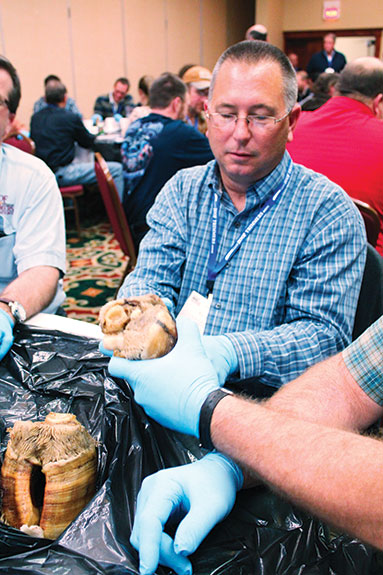Nearly 200 professional hoof trimmers traveled to California dairy country in February to expand their knowledge and sharpen their skills. Hoof Trimmers Association’s (HTA) 2013 hoof health conference was held in Visalia, California, and included on-farm trimming demonstrations, equipment demonstrations and current information on hoof health delivered by leading researchers.
An international organization, HTA is based in the U.S. and has members in all countries that support a dairy industry.
“We don’t just trim hooves, we recognize problems and try to correct them,” veteran Canadian hoof trimmer Vic Daniel said of association members. Whether hoof issues are infectious, metabolic or mechanical, Daniel said trimmers need to recognize the origin of hoof problems, investigate and work with owners or managers to eliminate or reduce the source.
Daniel, who also serves on the association’s board of directors, trims about 8,000 head of cattle annually, serving 54 herds in several Ontario counties. The hoof trimmer conferences are held every 18 months, Daniel said, and they focus on new research, trends and helping trimmers improve their business skills.
Daniel said that more dairy owners and managers are asking their trimmers about hoof problems and going the extra mile to investigate causes and try solutions.
“This new generation of dairymen is asking our opinion,” said Daniel.
That gives trimmers responsibility for recording ailments and giving benchmarks for lameness. The goal, added Daniel, is less than 10 percent lameness in a herd. If the percentage is above 30, the trimmer needs to help the owner solve the problem.
“We are part of the system now,” said Daniel.
Working with cows on a dairy means trimmers are involved in animal welfare and food safety issues. As more quality assurance audits are being conducted by milk industry customers, Daniel said that trimmers need to be more knowledgeable about their role in the herd health system.
New technology, power tools and restraint systems have made the trimmer’s physical job easier, but changes in the dairy industry have presented challenges.
Dairy design can come into play in causing lameness. One bad spot can cause a lot of damage, he added. Trimmers have to watch the footsteps of a cow from barn or corral to milk parlor to determine the origin of the hoof problem.
Story continues below photo slideshow. Photos by Cecilia Parsons.
Colorado trimmer Steve Bartell said dairy producers who watch their cows walk and take the time to fix problems make his job easier. Bartell said he has worked on dairies with a few as seven cows and as many as 2,300, and the attention paid by producers makes a difference in treating hoof problems.
“They have to look at the cows, not just the data on the computer,” said Bartell.
Nutrition and environment on dairies everywhere brought about changes in hoof health and trimming, confirmed Wisconsin trimmer Jerry Bowman. High-energy cow diets can affect hoof health as well as concrete flooring. Free access to dirt would do cows a lot of good, Bowman said.

Conference presentations included exploration of the interior of the bovine hoof.
Christoph Muelling, a veterinarian from Free University in Berlin, Germany, and a noted researcher in foot problems in cows, offered a conference first: a 3-D animation of a hoof interior.
The close-up look at interior structures allowed for clear descriptions of hoof parts and their functions.
The presentation also included a preserved hoof for participants, who were encouraged to explore the inner structures.
Dr. Dorte Dopfer from University of Wisconsin presented current research on prevention and therapy of digital dermatitis, including functional claw trimming. There is no “magic” treatment, prevention or control for this infectious claw disease, she stressed.
A manageable state of the disease on a dairy includes attention to animal welfare, the economics of treatment including treatment, labor and culling, and public opinion – the perception on how cows are treated.
The conference also included herd-level hoof problem-solving with Dr. Gerard Cramer and panel discussions with speaker. Cramer touched on communication with dairy owners and managers about causes for lameness.
“Start by asking the producers if they think there is a problem,” Cramer advised.
Trimming demonstrations and new equipment drew a crowd to the Rob Van Grouw Dairy just north of town on the final day of the conference.
There were three trimming stations with experienced trimmers explaining their techniques and opinions on hoof care working on heifers and cows. Two tilt tables, common in California, were in use, along with an upright machine from Appleton, Wisconsin.
Craig Hess from Appleton, a long-time trimmer, said the uprights, which can adjust to the size of a cow and hold them in an upright position, are more common in the Midwest.
Hess said cows in the upright are easier to position. Instead of rope restraints for legs, the cow’s legs are clamped and moved into position for trimming.
“It takes out a lot of the frustration of handling cows,” he said. PD
Cecilia Parsons is a freelance writer based in Ducor, California.
PHOTOS
Hoof trimming demonstrations during the 2013 Hoof Trimmers Association conference focused on proper shape of healthy hooves and diagnosis of common hoof ailments. Pictured is Dr. Chuck Guard of Cornell University .
BOTTOM RIGHT: Hooftrimmer Mike Wallen (above) of Tulare, California examines an inner hoof structure during a presentation by German veterinarian and anatomical researcher Christoph Muelling. Muelling’s presentation also included the new EFFIGOS Hoof and Claw Explorers, an animated 3-D look at the inner workings of the hoof. Photos courtesy of Cecilia Parsons.









